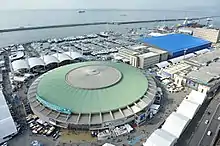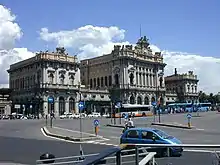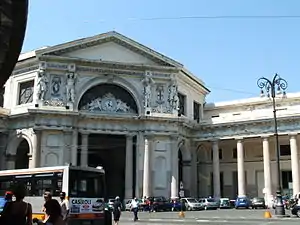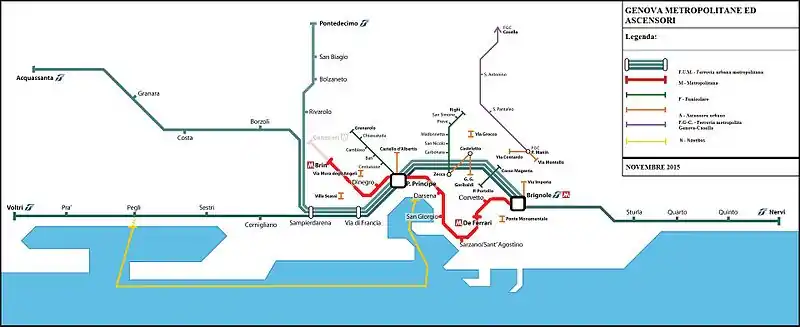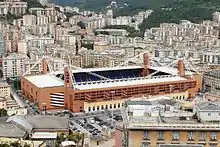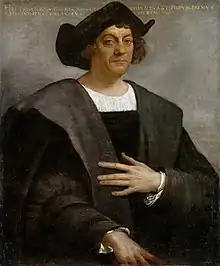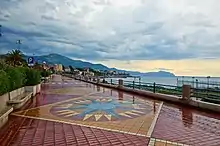Genoa
Genoa (/ˈdʒɛnoʊə/ JEN-oh-ə; Italian: Genova [ˈdʒɛːnova] (![]() listen); Ligurian: Zêna [ˈzeːna]; English, historically, and Latin: Genua) is the capital of the Italian region of Liguria and the sixth-largest city in Italy. In 2015, 594,733 people lived within the city's administrative limits.[3] As of the 2011 Italian census, the Province of Genoa, which in 2015 became the Metropolitan City of Genoa,[4] had 855,834 resident persons.[5] Over 1.5 million people live in the wider metropolitan area stretching along the Italian Riviera.[6]
listen); Ligurian: Zêna [ˈzeːna]; English, historically, and Latin: Genua) is the capital of the Italian region of Liguria and the sixth-largest city in Italy. In 2015, 594,733 people lived within the city's administrative limits.[3] As of the 2011 Italian census, the Province of Genoa, which in 2015 became the Metropolitan City of Genoa,[4] had 855,834 resident persons.[5] Over 1.5 million people live in the wider metropolitan area stretching along the Italian Riviera.[6]
Genoa
| |||||||||||||||||||
|---|---|---|---|---|---|---|---|---|---|---|---|---|---|---|---|---|---|---|---|
| Comune di Genova | |||||||||||||||||||
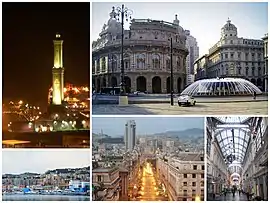 A collage of Genoa, clockwise from top left: Lighthouse of Genoa, Piazza De Ferrari, Galleria Mazzini, Brigata Liguria Street, view of San Teodoro from Port of Genoa | |||||||||||||||||||
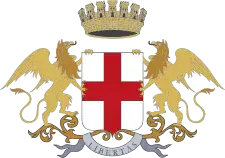 Coat of arms | |||||||||||||||||||
Location of Genoa 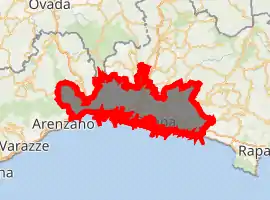
| |||||||||||||||||||
 Genoa Location of Genoa in Liguria 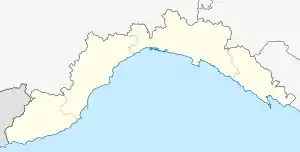 Genoa Genoa (Liguria) | |||||||||||||||||||
| Coordinates: 44°24′40″N 8°55′58″E | |||||||||||||||||||
| Country | Italy | ||||||||||||||||||
| Region | Liguria | ||||||||||||||||||
| Metropolitan city | Genoa (GE) | ||||||||||||||||||
| Government | |||||||||||||||||||
| • Mayor | Marco Bucci | ||||||||||||||||||
| Area | |||||||||||||||||||
| • Total | 240.29 km2 (92.78 sq mi) | ||||||||||||||||||
| Elevation | 20 m (70 ft) | ||||||||||||||||||
| Population (1 January 2018)[2] | |||||||||||||||||||
| • Total | 580,097 | ||||||||||||||||||
| • Density | 2,400/km2 (6,300/sq mi) | ||||||||||||||||||
| Demonym(s) | Genovese | ||||||||||||||||||
| Time zone | UTC+1 (CET) | ||||||||||||||||||
| • Summer (DST) | UTC+2 (CEST) | ||||||||||||||||||
| Postal code | 16121-16167 | ||||||||||||||||||
| Dialing code | 010 | ||||||||||||||||||
| ISTAT code | 010025 | ||||||||||||||||||
| Patron saint | John the Baptist | ||||||||||||||||||
| Saint day | 24 June | ||||||||||||||||||
| Website | www.comune.genova.it | ||||||||||||||||||
| |||||||||||||||||||
On the Gulf of Genoa in the Ligurian Sea, Genoa has historically been one of the most important ports on the Mediterranean: it is currently the busiest in Italy and in the Mediterranean Sea and twelfth-busiest in the European Union.[7][8]
Genoa was the capital of one of the most powerful maritime republics for over seven centuries, from the 11th century to 1797.[9] Particularly from the 12th century to the 15th century, the city played a leading role in the commercial trade in Europe, becoming one of the largest naval powers of the continent and considered among the wealthiest cities in the world.[10][11] It was also nicknamed la Superba ("the proud one") by Petrarch due to its glories on the seas and impressive landmarks.[12]
The city has hosted massive shipyards and steelworks since the 19th century, and its solid financial sector dates back to the Middle Ages. The Bank of Saint George, founded in 1407, is the oldest known state deposit bank in the world and has played an important role in the city's prosperity since the middle of the 15th century.[13][14]
The historial center, also known as old town, of Genoa is one of the largest and most-densely populated in Europe.[15] Part of it was also inscribed on the World Heritage List (UNESCO) in 2006 as Genoa: Le Strade Nuove and the system of the Palazzi dei Rolli.
Genoa is also home to the University of Genoa, which has a history going back to the 15th century, when it was known as Genuense Athenaeum. The city's rich cultural history in art, music and cuisine allowed it to become the 2004 European Capital of Culture. It is the birthplace of Guglielmo Embriaco, Christopher Columbus, Andrea Doria, Niccolò Paganini, Giuseppe Mazzini, Renzo Piano and Grimaldo Canella, founder of the House of Grimaldi, among others.
Genoa, which forms the southern corner of the Milan-Turin-Genoa industrial triangle of Northwest Italy, is one of the country's major economic centers.[16][17] A number of leading Italian companies are based in the city, including Fincantieri, Selex ES,[18] Ansaldo Energia,[19] Ansaldo STS, Edoardo Raffinerie Garrone, Piaggio Aerospace, Mediterranean Shipping Company and Costa Cruises.
Name
The city's modern name may derive from the Latin word meaning "knee" (genu; plural, genua) but there are other theories. It could derive from the god Janus, because Genoa, like him, has two faces: a face that looks at the sea and another turned to the mountains. Or it could come from the Latin word ianua, also related to the name of the God Janus, and meaning "door" or "passage." Besides that, it may refer to its geographical position at the centre of the Ligurian coastal arch. The Latin name, oppidum Genua, is recorded by Pliny the Elder (Nat. Hist. 3.48) as part of the Augustean Regio IX Liguria.[20]
Another theory traces the name to the Etruscan word Kainua which means "New City", based on an inscription on a pottery sherd reading Kainua, which suggests that the Latin name may be a corruption of an older Etruscan one with an original meaning of "new town".[21]
History
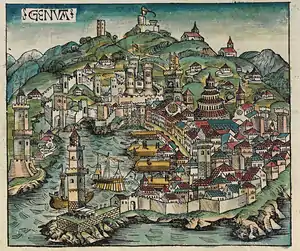
The city's area has been inhabited since the fifth or fourth millennium BC, what makes it one of the oldest continuously inhabited cities in the world.[22] In the 5th century BC the first town, or oppidum, was founded at the top of the hill today called Castello (Castle), which is now inside the medieval old town.[23] Among the ancient inhabitants of the region were the Ligures, that gave the name to the modern Liguria.[24]
Genoa is a port city by birth, establishing itself as the merchant capital of the newly established Republic of Genoa in the 11th century and maintaining its independence until 1797. The republic was one of the states known as Repubbliche Marinare along with Venice, Pisa, and Amalfi. Trade, shipbuilding, and banking helped support one of the largest and most powerful navies in the Mediterranean. There is an old saying that says: Genuensis ergo mercator, or "A Genoese therefore a merchant" but the Genoese were skilled sailors and ferocious warriors in addition (see also the Genoese crossbowmen).[25]
Throughout its existence the Republic had different forms of government, the most notable of these was the Dogate, that in actuality, was an oligarchy ruled by a group of wealthy merchant families, from whom the doges were selected. Internal feuds between the powerful families, such as the Grimaldi, the Fieschi, the Doria, the Spinola and others, caused much disruption, but in general the republic was run much as a business affair.
During the Late Middle Ages Genoa was one of the main commercial powers of the Mediterranean Sea, while between the 16th and 17th centuries it was one of the major financial centers in Europe.[26]
The Genoese have a claim to the creation of the rough denim cloth then called "Blue Jeans" (an anglicised spelling of Gênes, the French name of the city), nowadays shortened simply as jeans, used by sailors for work and to cover and protect their goods on the docks from the weather. During the Republic of Genoa, Genoese merchants and sailors exported this cloth throughout Europe. The production of Genoese lace was also notable.
The earliest known state deposit bank, Banco di San Giorgio (Bank of St. George), was founded in 1407 in Genoa.
Through Genoese participation in the Crusades, colonies were established in the Middle East, Northern Africa and across the Mediterranean. Genoese Crusaders brought home a green glass goblet from the Levant, which the Genoese have long regarded as the Holy Grail. In his Golden Legend, the Archbishop of Genoa, Jacobus de Voragine relates the history of the Holy Grail. The Holy Chalice is now kept in the Genoa Cathedral.
During its rise and its apogee, the Republic of Genoa founded colonies in many parts of the Mediterranean and Black Sea, nicknamed "la Dominante dei mari" ("the Dominant of the Seas"), leaving valuable architectural works in many locations, and also extending its direct domain in numerous territories, including Corsica (now in France), Tabarka (now in Tunisia), Chios, Samos and Mytilene (now in Greece), Gibelet (now in Lebanon), Giurgiu, Galați and Calafat (now in Romania), and Southern Crimea.[27]
Many aristocratic Genoese families, such as the Balbi, Doria, Grimaldi, Pallavicini and Serra, amassed tremendous fortunes. According to Felipe Fernandez-Armesto and others, the practices Genoa developed in the Mediterranean (such as chattel slavery) were crucial in the exploration and exploitation of the New World.[28]
Thereafter, Genovese bankers, financed many of the Spanish crown's foreign endeavors. Fernand Braudel has even called the period 1557 to 1627 the "age of the Genovese", "of a rule that was so discreet and sophisticated that historians for a long time failed to notice it".[29]
At the time of Genoa's zenith, the city attracted many artists including Rubens, Caravaggio and Van Dyck. The famed architect Galeazzo Alessi (1512–1572) designed many of the city's splendid palazzi, and Bartolomeo Bianco (1590–1657) designed the centrepieces of the University of Genoa. A number of Genoese Baroque and Rococo artists settled elsewhere and a number of local artists became prominent. In the late sixteenth century, Luca Cambiaso, known as the founder of the Genoese School of painting, went on to earn the largest payment then recorded (2,000 ducats) for work for Philip II of Spain in the Escorial palace in Madrid.
However, with the shift in world economy and trade routes to the New World and away from the Mediterranean, adding to the loss of several of its colonies, Genoa's political and economic power began a steady decline.[30]
It was 1796 that the Republic of Genoa finally ended, replaced by Napoleonic ruled Ligurian Republic.[31] Since 1815 after the "Congresso di Vienna" Genoa was annexed to the Regno di Sardegna (Sardinia Kingdom).
In the 19th and the early 20th centuries, Genoa consolidated its role as a major seaport and an important steel and shipbuilding centre. In Genoa in 1853, Giovanni Ansaldo founded Gio. Ansaldo & C. whose shipyards would build some of the most beautiful ships in the world, such as ARA Garibaldi, SS Roma, MS Augustus, SS Rex, SS Andrea Doria, SS Cristoforo Colombo, MS Gripsholm, SS Leonardo da Vinci, SS Michelangelo, and SS SeaBreeze. In 1854, the ferry company Costa Crociere was founded in Genoa and then the Lloyd Italiano maritime insurance company. In 1861 the Registro Italiano Navale Italian register of shipping was created, and in 1879 the Yacht Club Italiano. The owner Raffaele Rubattino in 1881 was among the founders of the ferry company Navigazione Generale Italiana which then become the Italian Line.[32]
Flag
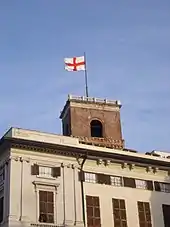
The flag of Genoa is a St. George's Cross, a red cross on a white field.
The patron saint of Genoa was Saint Lawrence until at least 958, but the Genoese transferred their allegiance to Saint George (and Saint John the Baptist) at some point during the 11th or 12th century, most likely with the rising popularity of the military saint during the Crusades. Genoa also had a banner displaying a cross since at latest 1218, possibly as early as 1113.[33] But the cross banner was not associated with the saint; indeed, the saint had his own flag, the vexillum beati Georgii (first mentioned 1198), a red flag showing George and the dragon. A depiction of this flag is shown in the Genoese annals under the year 1227. The Genoese flag with the red cross was used alongside this "Saint George's flag", from at least 1218, known as the insignia cruxata comunis Janue ("cross ensign of the commune of Genoa").
The saint's flag was the city's main war flag, but the cross flag was used alongside it in the 1240s.[34]
The Saint George's flag (i.e. the flag depicting the saint) remained the main flag of Genoa at least until the 1280s. The flag now known as the "St. George's Cross" seems to have replaced it as Genoa's main flag at some point during the 14th century. The Book of Knowledge of All Kingdoms (c. 1385) shows it, inscribed with the word iustiçia, and described as:
And the lord of this place has as his ensign a white pennant with a red cross. At the top it is inscribed with 'justice', in this manner.[35]
While it has been claimed by some that the flag of England was adopted from the Genoese flag during the First Crusade in 1190, historians conclusively have pointed to a lack of evidence of the Genoese flag had any relationship to the English one.[36]
Geography
The city of Genoa covers an area of 243 square kilometres (94 sq mi) between the Ligurian Sea and the Apennine Mountains. The city stretches along the coast for about 30 kilometres (19 mi) from the neighbourhood of Voltri to Nervi, and for 10 kilometres (6.2 mi) from the coast to the north along the valleys Polcevera and Bisagno. The territory of Genoa is popularly divided into 5 main zones: the centre, the west, the east, the Polcevera and the Bisagno Valley.
Genoa is adjacent to two popular Ligurian vacation spots: Camogli and Portofino. In the metropolitan area of Genoa lies Aveto Natural Regional Park.
Climate
Genoa has a humid subtropical climate (Cfa) in the Köppen climate classification, since only one summer month has less than 40 millimetres (1.57 in) of rainfall, preventing it from being classified as solely oceanic or Mediterranean, with a special note for the Genoa low.
The average yearly temperature is around 19 °C (66 °F) during the day and 13 °C (55 °F) at night. In the coldest months: December, January and February, the average temperature is 12 °C (54 °F) during the day and 6 °C (43 °F) at night. In the warmest months – July and August – the average temperature is 27.5 °C (82 °F) during the day and 21 °C (70 °F) at night. The daily temperature range is limited, with an average range of about 6 °C (11 °F) between high and low temperatures. Genoa also sees significant moderation from the sea, in stark contrast to areas behind the Ligurian mountains such as Parma, where summers are hotter and winters are quite cold.
Annually, the average 2.9 of nights recorded temperatures of ≤0 °C (32 °F) (mainly in January). The coldest temperature ever recorded was −8 °C (18 °F) on the night of February 2012; the highest temperature ever recorded during the day is 38.5 °C (101 °F) on the August 2015. Average annual number of days with temperatures of ≥30 °C (86 °F) is about 8, average four days in July and August.[37]
Average annual temperature of the sea is 17.5 °C (64 °F), from 13 °C (55 °F) in the period January–March to 25 °C (77 °F) in August. In the period from June to October, the average sea temperature exceeds 19 °C (66 °F).[38]
Genoa is also a windy city, especially during winter when northern winds often bring cool air from the Po Valley (usually accompanied by lower temperatures, high pressure and clear skies). Another typical wind blows from southeast, mostly as a consequence of Atlantic disturbances and storms, bringing humid and warmer air from the sea. Snowfall is sporadic, but does occur almost every year, albeit big amounts in the city centre are rare.[39][40]
Annual average relative humidity is 68%, ranging from 63% in February to 73% in May.[37]
Sunshine hours total above 2,200 per year, from an average 4 hours of sunshine duration per day in winter to average 9 hours in summer. This value is an average between the northern half of Europe and North Africa.[38]
| Climate data for Genoa (1971–2000 normals) | |||||||||||||
|---|---|---|---|---|---|---|---|---|---|---|---|---|---|
| Month | Jan | Feb | Mar | Apr | May | Jun | Jul | Aug | Sep | Oct | Nov | Dec | Year |
| Average high °C (°F) | 11.5 (52.7) |
12.2 (54.0) |
14.6 (58.3) |
16.8 (62.2) |
20.5 (68.9) |
23.9 (75.0) |
27.3 (81.1) |
27.7 (81.9) |
24.4 (75.9) |
20.0 (68.0) |
15.1 (59.2) |
12.5 (54.5) |
18.9 (66.0) |
| Daily mean °C (°F) | 8.5 (47.3) |
9.1 (48.4) |
11.4 (52.5) |
13.7 (56.7) |
17.4 (63.3) |
20.8 (69.4) |
24.1 (75.4) |
24.4 (75.9) |
21.1 (70.0) |
16.9 (62.4) |
12.2 (54.0) |
9.5 (49.1) |
15.7 (60.3) |
| Average low °C (°F) | 5.5 (41.9) |
6.0 (42.8) |
8.2 (46.8) |
10.5 (50.9) |
14.2 (57.6) |
17.6 (63.7) |
20.9 (69.6) |
21.0 (69.8) |
17.9 (64.2) |
13.8 (56.8) |
9.2 (48.6) |
6.5 (43.7) |
12.6 (54.7) |
| Average rainfall mm (inches) | 101.8 (4.01) |
74.0 (2.91) |
81.7 (3.22) |
88.0 (3.46) |
72.4 (2.85) |
58.2 (2.29) |
24.2 (0.95) |
69.3 (2.73) |
136.4 (5.37) |
171.3 (6.74) |
108.8 (4.28) |
93.1 (3.67) |
1,079.2 (42.49) |
| Average rainy days (≥ 1.0 mm) | 7.7 | 5.6 | 6.9 | 8.1 | 7.0 | 5.0 | 2.8 | 5.0 | 6.0 | 8.0 | 7.1 | 6.5 | 75.7 |
| Average snowy days | 0.9 | 0.5 | 0.2 | 0.0 | 0.0 | 0.0 | 0.0 | 0.0 | 0.0 | 0.0 | 0.0 | 0.7 | 2.3 |
| Mean monthly sunshine hours | 117.8 | 130.5 | 158.1 | 192.0 | 220.1 | 246.0 | 294.5 | 266.6 | 201.0 | 173.6 | 111.0 | 111.6 | 2,222.8 |
| Source 1: Servizio Meteorologico,[37] data of sunshine hours[41] | |||||||||||||
| Source 2: Rivista Ligure "La neve sulle coste del Maditerraneo" [42] | |||||||||||||
Government
Municipal government
The Municipal Council of Genoa is currently led by a right-wing majority, elected in June 2017. The mayor is Marco Bucci, expression of a right-wing alliance composed by Forza Italia, Lega Nord, Fratelli d'Italia and other minor lists. Genoa was traditionally considered a leftist city and Bucci is the first right-wing mayor since 1975.
Administrative subdivision
The city of Genoa is subdivided into nine municipi (administrative districts), as approved by the Municipal Council in 2007.[43]
| Municipio | Population (% of total) | Quartieri |
|---|---|---|
| Centro-Est | 91,402 (15.0%) | Prè, Molo, Maddalena, Oregina, Lagaccio, San Nicola, Castelletto, Manin, San Vincenzo, Carignano |
| Centro-Ovest | 66,626 (10.9%) | Sampierdarena, Belvedere, Campasso, San Bartolomeo, San Teodoro, Angeli |
| Bassa Val Bisagno | 78,791 (12.9%) | San Fruttuoso, Sant'Agata, Marassi, Quezzi, Fereggiano, Forte Quezzi |
| Media Val Bisagno | 58,742 (9.6%) | Staglieno (Parenzo, San Pantaleo), Molassana, Sant'Eusebio, Montesignano, Struppa (Doria, Prato) |
| Valpolcevera | 62,492 (10.3%) | Rivarolo, Borzoli Est, Certosa, Teglia, Begato, Bolzaneto, Morego, San Quirico, Pontedecimo |
| Medio Ponente | 61,810 (10.1%) | Sestri, Borzoli Ovest, San Giovanni Battista, Cornigliano, Campi, Calcinara, |
| Ponente | 63,027 (10.3%) | Voltri, Crevari, Pra', Palmaro, Ca' Nuova, Pegli, Multedo, Castelluccio |
| Medio Levante | 61,759 (10.1%) | Foce, Brignole, San Martino, Chiappeto, Albaro, San Giuliano, Lido, Puggia |
| Levante | 66,155 (10.8%) | Sturla, Quarto, Quartara, Castagna, Quinto al Mare, Nervi, Apparizione, Borgoratti, San Desiderio, Bavari, Sant'Ilario |
Cityscape
Main sights
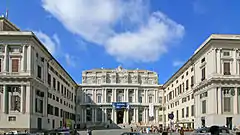
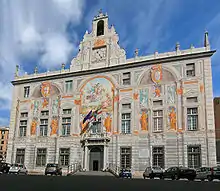
Notable to the city are the Palazzi dei Rolli, included in UNESCO World Heritage Site Genoa: Le Strade Nuove and the system of the Palazzi dei Rolli. The world-famous Strade Nuove are via Garibaldi (Strada Nuova), via Cairoli (Strada Nuovissima) and via Balbi (Strada Balbi). Among the most important palaces are the Palazzo Rosso, Palazzo Bianco, Palazzo Podestà o di Nicolosio Lomellino, Palazzo Reale, Palazzo Angelo Giovanni Spinola, Palazzo Pietro Spinola di San Luca and Palazzo Spinola di Pellicceria.
Genoa's historic centre is articulated in a maze of squares and narrow caruggi (typical Genoese alleys). It joins a medieval dimension with following 16th century and Baroque interventions (the ancient Via Aurea, now Via Garibaldi).
Near Via Garibaldi, through the public elevator Castelletto Levante, one can reach one of the most scenic places in the city, Belvedere Castelletto. The centre of Genoa is connected to its upper part by ancient paths caught between tall palaces, called creuze. Walking along these small paths one can reach magnificent places like the Santuario di Nostra Signora di Loreto. Very beautiful is the upper ring road so-called Circonvallazione a Monte that includes Corso Firenze, Corso Paganini, Corso Magenta, Via Solferino, and Corso Armellini.
San Lorenzo cathedral has a splendid portal and the dome designed by Galeazzo Alessi. Inside is found the treasure of the Cathedral where among other objects there is also what is said to be the Holy Chalice.
The symbols of the city are the Lanterna (the lighthouse) (117 metres (384 feet) high), old and standing lighthouse visible in the distance from the sea (beyond 30 kilometres (19 miles)), and the monumental fountain of Piazza De Ferrari, recently restored, out-and-out core of the city's life. Near Piazza De Ferrari and Teatro Carlo Felice is the Mazzini Gallery, a typical nineteenth-century structure with many elegant shops and coffee bars.
Another tourist destination is the ancient seaside district of Boccadasse (which means "the mouth of the donkey"), with its multicolour boats, set as a seal to Corso Italia, the promenade which runs along the Lido d'Albaro, and known for its ice-creams. After Boccadasse you can continue along the sea up to Sturla.
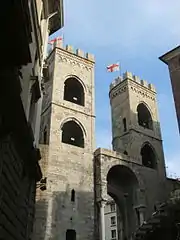
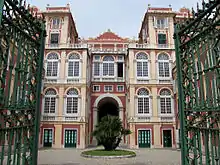
Just out of the city centre, but still part of the 33 km (21 mi) of coast included in the municipality's territory, are Nervi, natural doorway to the Ligurian East Riviera, and Pegli, the point of access to the West Riviera. Nervi offers many attractions: the promenade overlooking the sea called Passeggiata Anita Garibaldi; parks covered with lush tropical vegetation; numerous villas and palaces open to the public that now house museums (like GAM-Galleria d'Arte Moderna, Raccolte Frugone Museum, Museo Giannettino Luxoro and Wolfsoniana). (see also Parchi di Nervi) The East Riviera of Genoa called Riviera di Levante is part of the Italian Riviera. East Riviera is full of interesting towns to visit, and then from Genoa to east are: Bogliasco, Pieve Ligure, Sori, Recco, Camogli, Portofino, Santa Margherita Ligure, Rapallo, Zoagli, Chiavari, Lavagna and Sestri Levante. In the west, Pegli is the site of the famous Villa Durazzo-Pallavicini and Arenzano is a seaside town at the foot of the Parco naturale regionale del Beigua.
The new Genoa based its rebirth upon the restoration of the green areas of the immediate inland parts, among them the Parco naturale regionale del Beigua, and upon the construction of facilities such as the Aquarium of Genoa in the Old Harbour – the biggest in Italy and one of the major in Europe – and its Marina (the tourist small port which holds hundreds of pleasure boats). All of these are inside the restored Expo Area, arranged in occasion of the Columbian Celebrations of 1992.
Near the city are Camogli and San Fruttuoso abbey accessible by a daily ferry from the Old Harbour (Porto Antico) of Genoa. In the seabed in front of the San Fruttuoso abbey there is the Christ of the Abyss. From the Old Harbour one can reach by boat other famous seaside places around Genoa such as Portofino or a little more distant, Lerici and the Cinque Terre.
The regained pride gave back to the city the consciousness of being capable of looking to the future without forgetting its past. The resumption of several flourishing hand-crafting activities, far-back absent from the caruggi of the old town, is a direct evidence of it. The restoration of many of Genoa's churches and palaces in the 1980s and the 1990s contributed to the city's rebirth. A notable example the Renaissance, Basilica of Santa Maria Assunta, sitting on the top of the hill of Carignano and visible from almost every part of the city. The total restoration of Doge's Palace and of the Old Harbour, and the rebuilding of Teatro Carlo Felice, destroyed by bombing in the Second World War, were two more points of strength for the realisation of a new Genoa.
Genoa could not renounce, especially as from the 1960s, to a great renewal, which as happened in several other metropolis, should necessarily get through the realisation of big public housing complexes, whose quality, utility and functionality has been and still is controversial for those residents living there. Concerning this, the most known cases are those of the so-called "Biscione", a development in the shape of a long snake, situated on the hills of the populous district of Marassi, and the one of the group of houses known as "Le Lavatrici" (the washing machines), in the district of Prà.
Beyond a complete restyling of the area, the ancient port zone nearby the Mandraccio opening, in Porta Siberia, was enriched by Genoese architect Renzo Piano with a large sphere made of metal and glass, installed in the port's waters, not far from the Aquarium of Genoa, and unveiled in 2001 in occasion of the G8 Summit held in Genoa. The sphere (called by the citizens "Piano's bubble" or "The Ball"), after hosting an exposition of fens from Genoa's Botanical Gardens, currently houses the reconstruction of a tropical environment, with several plants, little animals and butterflies. Piano also designed the subway stations and, in the hills area, the construction – in collaboration with UNESCO – of Punta Nave, base of the Renzo Piano Building Workshop.
Nearby the Old Harbour is the so-called "Matitone", a skyscraper in shape of a pencil, that lays side by side with the group of the WTC towers, core of the San Benigno development, today base of part of the Municipality's administration and of several companies.
Churches
St. Lawrence Cathedral (Cattedrale di San Lorenzo) is the city's cathedral, built in a Gothic-Romanesque style. Other notable historical churches are the Commandery of the Saint John's Order called Commenda di San Giovanni di Prèl, San Matteo, San Donato, Santa Maria di Castello, Sant'Agostino (deconsecrated since the 19th century, sometimes is used for theatrical representations), Santo Stefano, Santi Vittore e Carlo, Basilica della Santissima Annunziata del Vastato, San Pietro in Banchi, Santa Maria delle Vigne, Nostra Signora della Consolazione, San Siro, Santa Maria Maddalena, Santa Maria Assunta di Carignano and Chiesa del Gesù. San Bartolomeo degli Armeni houses the Image of Edessa and San Pancrazio after the World War II was entrusted to the ligurian delegation of the Sovereign Military Order of Malta. These churches and basilicas are built in Romanesque (San Donato, Santa Maria di Castello, Commenda di San Giovanni di Pré), Gothic (San Matteo, Santo Stefano, Sant'Agostino), Baroque (San Siro) or Renaissance (Santa Maria Assunta di Carignano, San Pietro in Banchi) appearance, or a mix of different styles (Nostra Signora della Consolazione, Santissima Annunziata del Vastato; this last has a Baroque interior and a Neoclassicist façade).
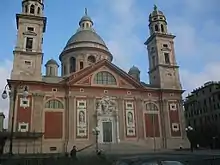
Another well known Genoese church is the shrine of Saint Francis of Paola, notable for the outer courtyard overlooking the port and the memorial to all those who died at sea. This church is of artistic mention in that the tile depictions of the Via Crucis Stations along the brick path to the church.
Near Genoa is found the Shrine of Nostra Signora della Guardia, (the sanctuary is said to have inspired the writer Umberto Eco in making his novel The Name of the Rose). Another interesting church in the neighborhoods of Genoa is San Siro di Struppa.
The city was the birthplace of several popes (Innocent IV, Adrian V, Innocent VIII, and Benedict XV) and various saints (Syrus of Genoa, Romulus of Genoa, Catherine of Genoa, and Virginia Centurione Bracelli). The Archbishop of Genoa Jacobus de Varagine wrote the Golden Legend. Also from Genoa were: Giovanni Paolo Oliva, the Superior General of the Society of Jesus; Girolamo Grimaldi-Cavalleroni, the Archbishop of Aix; Ausonio Franchi, priest, philosopher, and theologian; Cardinal Giuseppe Siri; and the priests Francesco Repetto, Giuseppe Dossetti, Gianni Baget Bozzo, and Andrea Gallo. The present archbishop of Genoa, Cardinal Angelo Bagnasco, comes from a Genoese family but was born in Pontevico, near Brescia (see also Archdiocese of Genoa).
Buildings and palaces
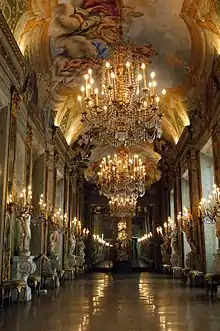
The main features of central Genoa include the Piazza De Ferrari, around which are the Opera and the Palace of the Doges.
The Palazzo di San Giorgio was the headquarters of the Bank of Saint George and was the place where Marco Polo and Rustichello da Pisa composed The Travels of Marco Polo.
Outside the city walls is Christopher Columbus House, where Christopher Columbus is said to have lived as a child. The current building is an 18th-century reconstruction of the original which was destroyed by the French naval bombing of 1684.
.jpg.webp)
Strada Nuova (now Via Garibaldi), in the old city, was inscribed on the World Heritage List in 2006. This district was designed in the mid-16th century to accommodate Mannerist palaces of the city's most eminent families. In Genoa there are 114 noble palaces (see also Rolli di Genova): among these 42 are inscribed on the World Heritage List. Among the Palazzi dei Rolli the most famous are Palazzo Rosso (now a museum), Palazzo Bianco, Palazzo Tursi, Palazzo Gerolamo Grimaldi, Palazzo Podestà, Palazzo Reale, Palazzo Angelo Giovanni Spinola, Palazzo Pietro Spinola di San Luca, Palazzo Spinola di Pellicceria, Palazzo Cicala. Palazzo Bianco and Palazzo Rosso are also known as Musei di Strada Nuova. The famous art college is also located on this street. The Genoese artistic renaissance begins with the construction of Villa del Principe commissioned by Andrea Doria: the architects were Giovanni Angelo Montorsoli and Giovanni Ponzello, the interior was painted by Perino del Vaga and the garden fountain was realised by Taddeo Carlone. In 1548 Galeazzo Alessi, with the project of Villa Giustiniani-Cambiaso, designed a new prototype of Genoese palace that would be an inspiration to other architects working in Genoa as Bartolomeo Bianco, Pietro Antonio Corradi, Rocco Lurago, Giovan Battista Castello, and Bernardino Cantone. Peter Paul Rubens wrote Palazzi di Genova in 1622, a book dedicated to the palaces of Genoa.
Scattered around the city are many villas, built between the fifteenth and the twentieth centuries. Among the best known are: Villa Brignole Sale Duchessa di Galliera, Villa Durazzo-Pallavicini, Villa Doria Centurione, Villa Durazzo Bombrini, Villa Serra, Villa Giustiniani-Cambiaso, Villa Rossi Martini, Villa Imperiale Scassi, Villa Grimaldi, Villa Negrone Moro, Villa Rosazza, Villetta Di Negro, Villa delle Peschiere, Villa Imperiale, Villa Saluzzo Bombrini, and Villa Grimaldi Fassio.

As it regards the 19th century remember the architects Ignazio Gardella (senior), and Carlo Barabino which among other things, realises together with Giovanni Battista Resasco, the Monumental Cemetery of Staglieno. The cemetery is renowned for its statues and sepulchral monuments that preserve the mortal remains of notable personalities, including Giuseppe Mazzini, Fabrizio De André, and Constance Lloyd (Oscar Wilde's wife). In the first half of the 19th century they are completed the Albergo dei Poveri and the Acquedotto storico. In 1901 Giovanni Antonio Porcheddu realised the Silos Granari.
The city is rich in testimony of the Gothic Revival like Albertis Castle, Castello Bruzzo, Villa Canali Gaslini and Mackenzie Castle designed by the architect Gino Coppedè. Genoa is also rich of Art Nouveau works, among which: Palazzo della Borsa, Via XX Settembre, Hotel Bristol Palace, Grand Hotel Miramare and Stazione marittima. Works of Rationalist architecture of the first half of the 20th century are Torre Piacentini and Piazza della Vittoria where Arco della Vittoria, both designed by the architect Marcello Piacentini. Other architects who have changed the face of Genoa in the 20th century are: Ignazio Gardella, Luigi Carlo Daneri who realised the Piazza Rossetti and the residential complex so-called Il Biscione, Mario Labò, Aldo Rossi, Ludovico Quaroni, Franco Albini who designed the interiors of Palazzo Rosso, and Piero Gambacciani. The Edoardo Chiossone Museum of Oriental Art, designed by Mario Labò, has one of the largest collections of Oriental art in Europe.
Other notable architectural works include: the Old Harbour's new design with the Aquarium, the Bigo and the Biosfera by Renzo Piano, the Palasport di Genova, the Matitone skyscraper, and the Padiglione B of Genoa Fair, by Jean Nouvel. Genoa was home to the Ponte Morandi by Riccardo Morandi, built in 1967, collapsed in 2018 and demolished February–June 2019.[44]
Old harbour
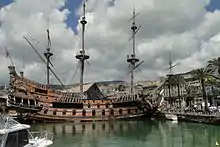
The old harbour ("porto antico" in Italian) is the ancient part of the port of Genoa. The harbour gave access to outside communities creating a good geographical situation for the city.[45] The city is spread out geographically along a section of the Liguria coast, which makes trading by ship possible. Before the development of car, train, and airplane travel, the main outside access for the city was the sea, as the surrounding mountains made trade north by land more difficult than coastal trade. Trade routes have always connected Genoa on an international scale, with increasingly farther reach starting from trade along Europe's coastline before the medieval period to today's connection across continents.[46] In its heyday the Genoese Navy was a prominent power in the Mediterranean.
As the Genoa harbour was so important to the merchants for their own economic success, other nearby harbours and ports were seen as competition for a landing point for foreign traders. In the 16th century, the Genovese worked to destroy the local shipping competition, the Savona harbour.[45] Taking matters into their own hands, the Genoa merchants and the politically powerful in Genoa attacked the harbour of Savona with stones.[45] This action was taken to preserve the economic stability and wealth of the city during the rise in prominence of Savona. The Genovese would go as far as to war with other coastal, trading cities such as Venice,[45] in order to protect the trade industry.
Renzo Piano redeveloped the area for public access, restoring the historical buildings (like the Cotton warehouses) and creating new landmarks like the Aquarium, the Bigo and recently the "Bolla" (the Sphere). The main touristic attractions of this area are the famous Aquarium and the Museum of the Sea (MuMA). In 2007 these attracted almost 1.7 million visitors.[47]
Walls and fortresses

The city of Genoa during its long history at least since the 9th century had been protected by different line of defensive walls. Large portions of these walls remain today, and Genoa has more and longer walls than any other city in Italy. The main city walls are known as "Ninth century walls", "Barbarossa Walls" (12th century), "Fourteenth century walls", "Sixteenth century walls" and "New Walls" ("Mura Nuove" in Italian). The more imposing walls, built in the first half of the 17th century on the ridge of hills around the city, have a length of almost 20 km (12 mi). Some fortresses stand along the perimeter of the "New Walls" or close them.
Parks

Genoa has 82,000 square metres (880,000 square feet) of public parks in the city centre, such as Villetta Di Negro which is right in the heart of the town, overlooking the historical centre. Many bigger green spaces are situated outside the centre: in the east are the Parks of Nervi (96,000 square metres or 1,030,000 square feet) overlooking the sea, in the west the beautiful gardens of Villa Durazzo Pallavicini and its Giardino botanico Clelia Durazzo Grimaldi (265,000 square metres or 2,850,000 square feet). The numerous villas and palaces of the city also have their own gardens, like Palazzo del Principe, Villa Doria, Palazzo Bianco and Palazzo Tursi, Palazzo Nicolosio Lomellino, Albertis Castle, Villa Rosazza, Villa Croce, Villa Imperiale Cattaneo, Villa Bombrini, Villa Brignole Sale Duchessa di Galliera, Villa Serra and many more.[48]
The city is surrounded by natural parks such as Parco naturale regionale dell'Antola, Parco naturale regionale del Beigua, Aveto Natural Regional Park and the Ligurian Sea Cetacean Sanctuary (a marine protected area).
Aquarium of Genoa
The Aquarium of Genoa (in Italian: Acquario di Genova) is the largest aquarium in Italy and among the largest in Europe. Built for Genoa Expo '92, it is an educational, scientific and cultural centre. Its mission is to educate and raise public awareness as regards conservation, management and responsible use of aquatic environments. It welcomes over 1.2 million visitors a year.
Control of the entire environment, including the temperature, filtration and lighting of the tanks was provided by local Automation Supplier Orsi Automazione, acquired in 2001 by Siemens. The Aquarium of Genoa is co-ordinating the AquaRing EU project. It also provides scientific expertise and a great deal of content for AquaRing, including documents, images, academic content and interactive online courses, via its Online Resource Centre.[49]
Demographics
| Year | Pop. | ±% |
|---|---|---|
| 1115 | 50,000 | — |
| 1300 | 100,000 | +100.0% |
| 1400 | 100,000 | +0.0% |
| 1400+ | 117,000 | +17.0% |
| 1861 | 242,447 | +107.2% |
| 1871 | 256,486 | +5.8% |
| 1881 | 289,234 | +12.8% |
| 1901 | 377,610 | +30.6% |
| 1911 | 465,496 | +23.3% |
| 1921 | 541,562 | +16.3% |
| 1931 | 590,736 | +9.1% |
| 1936 | 634,646 | +7.4% |
| 1951 | 688,447 | +8.5% |
| 1961 | 784,194 | +13.9% |
| 1971 | 816,872 | +4.2% |
| 1981 | 762,895 | −6.6% |
| 1991 | 678,771 | −11.0% |
| 2001 | 610,307 | −10.1% |
| 2011 | 608,493 | −0.3% |
| 2015 | 588,668 | −3.3% |
| Source: ISTAT 2001[50][51][52] | ||
At the beginning of 2011, there were 608,493 people residing in Genoa, of whom 47% were male and 53% were female. The city is characterised by rapid aging and a long history of demographic decline, that has shown a partial slowdown in the last decade. Genoa has the lowest birth rate and is the most aged of any large Italian city. Minors (children ages 18 and younger) totalled only 14.12% of the population compared to pensioners who number 26.67%. This compares with the Italian average of 18.06% (minors) and 19.94% (pensioners). The median age of Genoa's residents is 47, compared to the Italian average of 42. The current birth rate of the city is only 7.49 births per 1,000 inhabitants, compared to the national average of 9.45. As of 2006, 94.23% of the population was Italian. The largest immigrant group is from the Americas (mostly Ecuador): 2.76%, other European nations (mostly Albania, Ukraine, the former Yugoslavia and Romania): 1.37%, and North Africa: 0.62%. The city is predominantly Roman Catholic, with small numbers of Protestants.
Economy
The Genoa metropolitan area had a GDP amounting to $30.1 billion in 2011, or $33,003 per capita.[53]
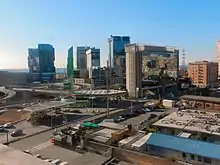
Ligurian agriculture has increased its specialisation pattern in high-quality products (flowers, wine, olive oil) and has thus managed to maintain the gross value-added per worker at a level much higher than the national average (the difference was about 42% in 1999).[54] The value of flower production represents over 75% of the agriculture sector turnover, followed by animal farming (11.2%) and vegetable growing (6.4%).
Steel, once a major industry during the booming 1950s and 1960s, phased out after the late 1980s crisis, as Italy moved away from the heavy industry to pursue more technologically advanced and less polluting productions. So the Ligurian industry has turned towards a widely diversified range of high-quality and high-tech products (food, shipbuilding (in Sestri Ponente and in metropolitan area – Sestri Levante), electrical engineering and electronics, petrochemicals, aerospace etc.). Nonetheless, the regions still maintains a flourishing shipbuilding sector (yacht construction and maintenance, cruise liner building, military shipyards).[54]
In the services sector, the gross value-added per worker in Liguria is 4% above the national average. This is due to the increasing diffusion of modern technologies, particularly in commerce and tourism. A good motorway network (376 km (234 mi) in 2000) makes communications with the border regions relatively easy. The main motorway is located along the coastline, connecting the main ports of Nice (in France), Savona, Genoa and La Spezia. The number of passenger cars per 1000 inhabitants (524 in 2001) is below the national average (584). On average, about 17 million tonnes of cargo are shipped from the main ports of the region and about 57 million tonnes enter the region.[54] The Port of Genoa, with a trade volume of 58.6 million tonnes[55] ranks first in Italy,[56] second in terms of twenty-foot equivalent units after the transshipment port of Gioia Tauro, with a trade volume of over 2 million TEUs.[57] The main destinations for the cargo-passenger traffic are Sicily, Sardinia, Corsica, Barcelona, and the Canary Islands.
Some companies based in Genoa include Ansaldo STS, Ansaldo Energia, Edoardo Raffinerie Garrone, Piaggio Aerospace, Registro Italiano Navale, Banca Carige, SLAM, and Costa Cruises.
Education
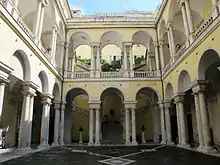
The first organised forms of higher education in Genoa date back to the 13th century when private colleges were entitled to award degrees in Medicine, Philosophy, Theology, Law, Arts.[58] Today the University of Genoa, founded in the 15th century, is one of the largest in Italy, with 11 faculties, 51 departments and 14 libraries. In 2007–2008, the University had 41,000 students and 6,540 graduates.[59]
Genoa is also home to other Colleges, Academies or Museums:
- The University of Genoa
- The CNR Area della Ricerca di Genova
- The Accademia ligustica di belle arti
- The Accademia Ligure di scienze e lettere
- The Istituto Italiano di Tecnologia
- The ISICT-istituto superiore di studi in tecnologie dell'informazione e della comunicazione
- The Renzo Piano Building Workshop
- The OBR Open Building Research
- The Accademia Italiana della Marina Mercantile
- The "Niccolò Paganini" Conservatory
- The Italian Hydrographic Institute
- The Deledda International School
- The Deutsche Schule Genua
- The Genoa Comics Academy
- The International School in Genoa
- The Russian Ballet College
The Italian Institute of Technology was established in 2003 jointly by the Italian Ministry of Education, Universities and Research and the Italian Minister of Economy and Finance, to promote excellence in basic and applied research. The main fields of research of the Institute are Neuroscience, Robotics, Nanotechnology, Drug discovery. The central research labs and headquarters are located in Morego, in the neighbourhood of Bolzaneto.[60]
Clemson University, based in South Carolina, United States has a villa in Genoa where architecture students and students in related fields can attend for a semester or year-long study program.
Florida International University (FIU), based in Miami, Florida, United States also has a small campus in Genoa, with the University of Genoa, which offers classes within the FIU School of Architecture.
Science
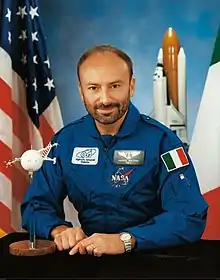
Genoa is the birthplace of Giovanni Battista Baliani and Vincentio Reinieri, of the geneticist Luigi Luca Cavalli-Sforza, of the Nobel Prize astrophysicist Riccardo Giacconi and of the astronaut Franco Malerba. The city is home to the Erzelli Hi-Tech Park, to the Istituto Italiano di Tecnologia, to the Istituto idrografico della Marina and annually hosts the Festival della Scienza. The city has an important tradition in the fields of the geology, paleontology, botany and naturalistic studies, among the most eminent personalities remember: Lorenzo Pareto, Luigi d'Albertis, Enrico Alberto d'Albertis, Giacomo Doria and Arturo Issel, we point the Orto Botanico dell'Università di Genova. Very important and renowned is the Istituto Giannina Gaslini.
In 1846 the city hosted the eighth Meeting of Italian Scientists and in 1902 Luigi Carnera discovered an asteroid and called it "485 Genua", dedicating it to the Latin name of Genoa.
Erzelli science technology park
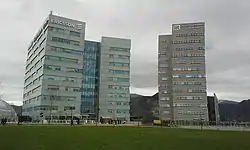
The western area of Genoa hosts the Erzelli GREAT Campus, an under construction science technology park which houses the high-tech corporations Siemens, Ericsson, Esaote, and robotics laboratories of the Italian Institute of Technology (IIT).[61] The Erzelli GREAT Campus science park is undergoing a process of enlargement, and in the future will host the new Faculty of Engineering of University of Genoa. The project has been struggling in recent years with enterprises laying off their employees and no real growth.[62][63]
Transport
Ports
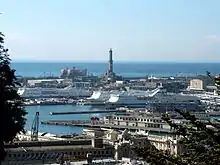
Several cruise and ferry lines serve the passenger terminals in the old port, with a traffic of 3.2 million passengers in 2007.[64] MSC Cruises chose Genoa as one of its main home ports, in competition with the Genoese company Costa Cruises, which moved its home port to Savona. The quays of the passenger terminals extend over an area of 250,000 square metres (2,700,000 square feet), with 5 equipped berths for cruise vessels and 13 for ferries, for an annual capacity of 4 million ferry passengers, 1.5 million cars and 250,000 trucks.[65] The historical maritime station of Ponte dei Mille is today a technologically advanced cruise terminal, with facilities designed after the world's most modern airports, to ensure fast embarking and disembarking of latest generation ships carrying thousand passengers. A third cruise terminal is currently under construction in the redesigned area of Ponte Parodi, once a quay used for grain traffic.
The Costa Concordia cruise ship, owned by Costa Cruises, was docked at the port before being dismantled.[66]
Air transport
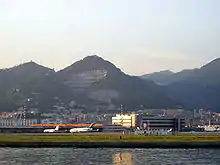
The Airport of Genoa (IATA: GOA, ICAO: LIMJ) (Italian: Aeroporto di Genova) also named Christopher Columbus Airport (Italian: Aeroporto Cristoforo Colombo) is built on an artificial peninsula, 4 NM (7.4 km; 4.6 mi) west[67] of the city. The airport is currently operated by Aeroporto di Genova S.P.A., which has recently upgraded the airport complex, that now connects Genoa with several daily flights to Rome, Naples, Paris, London, Madrid and Munich. In 2008, 1,202,168 passengers travelled through the airport,[68] with an increase of international destinations and charter flights.
Public transport
The main railway stations are Genoa Brignole in the east and Genoa Principe in the west. Genoa Brignole is close to the business districts and the exhibition centre, while the Principe is close to the port, the university and the historical centre. From these two stations depart the main trains connecting Genoa to France, Turin, Milan and Rome.
Genoa's third most important station is Genoa Sampierdarena, which serves the densely populated neighbourhood of Sampierdarena. 23 other local stations serve the other neighbourhoods on the 30-kilometre-long coast line from Nervi to Voltri and on the northern line through Bolzaneto and the Polcevera Valley.
The municipal administration of Genoa plans to transform these urban railway lines to be part of the rapid transit system, which now consists of the Metropolitana di Genova (Genoa Metro), a light metro connecting Brin to the city centre. The metro line was extended to Brignole Station in December 2012. Trains currently pass through Corvetto station between De Ferrari and Brignole without stopping. A possible further extension towards the eastern, densely populated boroughs was planned, but the municipal administration intends to improve the public transport by investing in new tram lines instead of completing the extension of the light metro.[69] The current stations of the metro line are Brin-Certosa, Dinegro, Principe, Darsena, San Giorgio, Sant'Agostino and De Ferrari, and the line is 5.3 km (3.3 mi) long.
The city's hilly nature has influenced its public transport. The city is served by two funicular railways (the Zecca–Righi funicular, the Sant'Anna funicular), the Quezzi inclined elevator, the Principe–Granarolo rack railway, and ten public lifts.[70]
The city's metro, bus and trolleybus network is operated by AMT (Azienda Mobilità e Trasporti S.p.A.). The Drin Bus is a demand responsive transport service that connects the hilly, low-density areas of Genoa.[71][72][73] The average time people spend commuting on public transit in Genova, for example to and from work, is 54 min on a weekday. 10% of public transit riders ride for more than 2 hours every day. The average time people wait at a stop or station for public transit is 12 min, while 13% of riders wait over 20 minutes on average every day. The average distance people usually ride in a single trip with public transit is 4 km, while 2% travel for over 12 km in a single direction.[74]
Culture
Visual arts
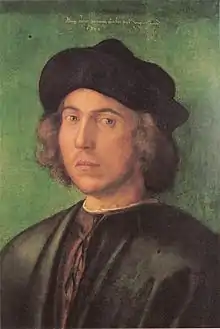
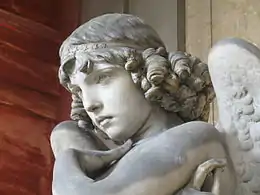
Genoese painters active in the 14th century include Barnaba da Modena and his local followers Nicolò da Voltri and at the same time, the sculptor Giovanni Pisano reached Genoa to make the monument for Margaret of Brabant, whose remains are today housed in the Museum of Sant'Agostino.
In the 16th century along with the flourishing trade between the Republic of Genoa and Flanders also grew the cultural exchanges. The painters Lucas and Cornelis de Wael lived in Genoa for a long time, where they played the role of a magnet for many Flemish painters like Jaan Roos, Giacomo Legi, Jan Matsys, Andries van Eertvelt and Vincent Malo.
This creative environment also attracted the two most important Flemish painters, Rubens and Van Dyck, who along with Bernardo Strozzi.[75] gave life to the Genoese Painting School of the 17th century.
Much of the city's art is found in its churches and palaces, where there are numerous Renaissance, Baroque and Rococo frescos. They are rich in works of art the Cathedral, the Chiesa del Gesù where The Circumcision and the "Miracles of St. Ignatius" by Rubens, the Assunzione della Vergine by Guido Reni. The Church of San Donato contains works of Barnaba da Modena, Nicolò da Voltri and Joos van Cleve,[75] the Church of Santo Stefano The Stoning of St. Stephen by Giulio Romano and the Church of Santa Maria Assunta the sculptures by Filippo Parodi and Pierre Puget, very interesting is the Santa Maria di Castello. But most of the works are kept in the Palaces like Palazzo Bianco where "Ecce Homo" by Caravaggio, "Susannah and the Elders" by Veronese, and the Garden Party in Albaro by Magnasco are kept, Palazzo Rosso with the Portrait of Anton Giulio Brignole-Sale by van Dyck, Cleopatra morente by Guercino and works of Dürer, Bernardo Strozzi, Mattia Preti, Veronese; Palazzo Spinola di Pellicceria where the "Portrait of Giovanni Carlo Doria on Horseback" by Rubens and Ecce Homo by Antonello da Messina (see also the series of Ecce Homo by Antonello da Messina) are kept, Palazzo Tursi with the Penitent Magdalene by Canova, and Palazzo Reale which contains works of Strozzi, Gaulli, Tintoretto, van Dyck, Simon Vouet, Guercino.
The most important Genoese painters are: Luca Cambiaso, Bernardo and Valerio Castello, Giovanni Benedetto Castiglione, Domenico and Paolo Gerolamo Piola, Gregorio De Ferrari, Bernardo Strozzi, Giovanni Battista Gaulli and Alessandro Magnasco. Sculptors include Filippo Parodi, the wood sculptor Anton Maria Maragliano, Francesco Maria Schiaffino and Agostino Carlini who was member of the Royal Academy.
The famous humanist author, architect, poet and philosopher Leon Battista Alberti was born in Genoa on 14 February 1404. Simonetta Vespucci, considered the most beautiful woman of her time, was also born in Genoa. She is portrayed in The Birth of Venus and Primavera by Sandro Botticelli and in Portrait of Simonetta Vespucci by Piero di Cosimo.
Genoa is also famous for its numerous tapestries, which decorated the city's many salons. Whilst the patrician palaces and villas in the city were and still are austere and majestic, the interiors tended to be luxurious and elaborate, often full of tapestries, many of which were Flemish.[75] Famous is the Genoese lace called with its name of Turkish origin macramè. Very used in Genoa is the cobblestone called Risseu and a kind of azulejo called laggioni.
Genoa has been likened by many to a Mediterranean New York, perhaps for its high houses that in the Middle Ages were the equivalent of today's skyscrapers, perhaps for the sea route Genoa-New York which in past centuries has been travelled by millions of emigrants. The architect Renzo Picasso in his visionary designs reinforces this strange affinity between the two cities.
In the Monumental Cemetery of Staglieno, you can admire some magnificent sculpture of the 19th century and early 20th century like Monteverde Angel by Giulio Monteverde, or works by artists such as Augusto Rivalta, Leonardo Bistolfi, Edoardo Alfieri, Santo Varni.
Amongst the most notable Genoese painters of the 19th century and of the first half of the 20th century are Tammar Luxoro, Ernesto Rayper, Rubaldo Merello, and Antonio Giuseppe Santagata. The sculptor Francesco Messina also grew up in Genoa.
In 1967 the Genoese historian, critic and curator Germano Celant coined the term Arte Povera. Enrico Accatino was another important art theorist and Emanuele Luzzati was the production designer and illustrator like Lorenzo Mongiardino, also a production designer and architect. Two other important artists are Emilio Scanavino and Vanessa Beecroft.
The yearly International Cartoonists Exhibition was founded in 1972 in Rapallo, near Genoa. A notable figure is the illustrator and comics artist Giovan Battista Carpi.
Literature
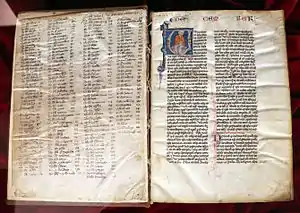
"Anonymous of Genoa" was one of the first authors in Liguria and Italy who wrote verses in the Vernacular. It explained that in Genoa Marco Polo and Rustichello da Pisa, in the prisons of Palazzo San Giorgio, wrote The Travels of Marco Polo. The Golden Legend is a collection of hagiographies written by the Archbishop of Genoa Jacobus de Voragine. To animate the Genoese literary environment of the 16th century were Gabriello Chiabrera and "Ansaldo Cebà", the latter best known for his correspondence with Sara Copia Sullam. The city has been the birthplace of the historian Caffaro di Rustico da Caschifellone, of the poet "Martin Piaggio", of the famous historian, philosopher and journalist Giuseppe Mazzini, of the writer Piero Jahier, of the poet Nobel Prize Eugenio Montale. The writer and translator Fernanda Pivano, the journalist "Vito Elio Petrucci" and the poet Edoardo Sanguineti, the literary critic Carlo Bo instead was born in Sestri Levante near Genoa. We have also remember the dialet poet Edoardo Firpo, the dialect "poeta crepuscolare" Giambattista Vigo, and the symbolist Ceccardo Roccatagliata Ceccardi. The city of Genoa has been an inspiration to many writers and poets among which: Dino Campana, Camillo Sbarbaro, Gaspare Invrea who wrote "The mouth of the wolf" and Giorgio Caproni. Between the alleys of the historical centre there is the Old Libreria Bozzi. The "Berio Civic Library" houses the precious manuscript entitled "The Durazzo Book of Hours". In the first half of the 20th century, the Mazzini Gallery's was a meeting place of many artists, writers and intellectuals among which Guido Gozzano, Salvatore Quasimodo, Camillo Sbarbaro, Francesco Messina, Pierangelo Baratono, Eugenio Montale. In the thirties of the 20th century was active in Genoa the Circoli magazine and after the World War II the "Il Gallo" magazine. Coveted and known from the 1960s to the 1980s was the Genoese literary lounge animated by the writer Minnie Alzona. Dutch writer Ilja Leonard Pfeijffer wrote "La Superba", a novel in which Genoa is prominently featured. This was followed by the autobiographical novel "Brieven uit Genua".
Since 1995, all the months of June take place in Genoa the Genoa's International Poetry Festival, conceived by Claudio Pozzani with the help of Massimo Bacigalupo.
Music
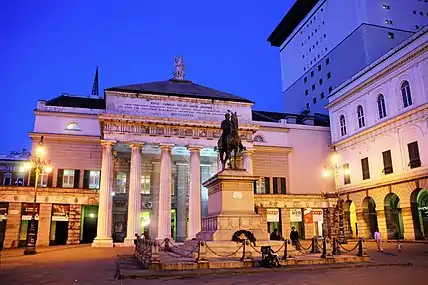
Genoa was a centre of Occitanie culture in Italy and for this reason it developed an important school of troubadours: Lanfranc Cigala, Jacme Grils, Bonifaci Calvo, Luchetto Gattilusio, Guillelma de Rosers, and Simon Doria.
Genoa is the birthplace of the composer Simone Molinaro, violinist and composer Niccolò Paganini, violinist Camillo Sivori and composer Cesare Pugni. In addition, the famous violin maker Paolo de Barbieri. Paganini's violin, Il Cannone Guarnerius, is kept in Palazzo Tursi. The city is the site of the Niccolò Paganini Music Conservatory.
Alessandro Stradella, a composer of the middle baroque, lived in Genoa and was assassinated in 1682.
Felice Romani was a poet who wrote many librettos for the opera composers like Gaetano Donizetti and Vincenzo Bellini. Giovanni Ruffini was another poet known for writing the libretto of the opera Don Pasquale for its composer.
In 1847, Goffredo Mameli and Michele Novaro composed "Il Canto degli Italiani".
In 1857, debuted the work of Giuseppe Verdi entitled Simon Boccanegra inspired by the first Doge of Genoa, Simone Boccanegra.
Genoa is also the birthplace of the condcuctor Fabio Luisi and of many opera singers like Giuseppe Taddei, Margherita Carosio, Luciana Serra, and Daniela Dessì.
The Teatro Carlo Felice was built in 1828 in the city in the Piazza De Ferrari, and named for the monarch of the then Kingdom of Sardinia (which included the present regions of Sardinia, Piedmont and Liguria). The theatre was the centre of music and social life in the 19th century. On various occasions in the history of the theatre, presentations have been conducted by Mascagni, Richard Strauss, Hindemith and Stravinsky. Other Genoese theaters are the Politeama Genovese, Teatro Stabile in Genoa, Teatro della Tosse and Teatro Gustavo Modena.
On the occasion of the Christopher Columbus celebration in 1992, new musical life was given to the area around the old port, including the restoration of the house of Paganini and presentations of the trallalero, the traditional singing of Genoese dock workers.
The trallalero, traditional music in the Genoese dialect, is a polyphonic vocal music, performed by five men and several songs. The trallalero are ancient songs that have their roots in the Mediterranean tradition. Another aspect of the traditional Genoese music is the "Nostalgic Song". The principal authors and singers of the Nostalgic Song in Genoese dialect are Mario Cappello who wrote the piece "Ma se ghe penso" (English: "But if I think about it"), a memory of Genoa by an emigrant to Argentina, Giuseppe Marzari, Agostino Dodero up to I Trilli, Piero Parodi, Buby Senarega, Franca Lai. The traditional Nostalgic Song will have a great influence on the so-called Scuola Genovese of singer-songwriters that in some cases will mix the nostalgic feeling with pop and jazz atmospheres.
The singer Natalino Otto started the swing genre in Italy and his friend and colleague Pippo Barzizza was a composer, arranger, conductor and music director. Other musicians, composers and arrangers are Angelo Francesco Lavagnino, Gian Piero Reverberi, Gian Franco Reverberi, Oscar Prudente, Pivio and Aldo De Scalzi.
Genoa in the second half of the 20th century was famous for an important school of Italian singer-songwriters, so-called Scuola Genovese, that includes Umberto Bindi, Luigi Tenco", "Gino Paoli", "Bruno Lauzi", "Fabrizio de André, Ivano Fossati, Angelo Branduardi" and Francesco Baccini. Nino Ferrer was also born in Genoa. In the 70s there were formed in Genoa numerous bands of Italian progressive rock like New Trolls, Picchio dal Pozzo, Latte e Miele, and Delirium. Today we point the band Buio Pesto and The Banshee band.
Some songs about the city of Genoa are part of Italian popular culture, like "Via del Campo" and "La Città Vecchia" by Fabrizio de André, "Genova per noi" by Paolo Conte, "La Casa in Via del Campo" the song also sung by Amalia Rodrigues and "Piazza Alimonda" the song about the facts of Genoa 2001 by Francesco Guccini.
Fabrizio de André in 1984 released the album Crêuza de mä, totally written in Genoese dialect.
I Madrigalisti di Genova is a vocal and instrumental group formed in 1958 which specialised in medieval and Renaissance repertoire
The city has numerous music festivals, among which are Concerts at San Fruttuoso abbey, Premio Paganini, I Concerti di San Torpete, International Music Festival Genova, We Love Jazz, Gezmatz Festival & Workshop, and Goa-Boa Festival. In the town of Santa Margherita Ligure the ancient abbey of Cervara is often the site of chamber music.
Giovine Orchestra Genovese, one of the oldest concert societies in Italy, was founded in Genoa in 1912.
Cinema
Genoa has been the set for many films and especially for the genre called Polizieschi. Notable directors born in Genoa include Pietro Germi and Giuliano Montaldo, the actors: Gilberto Govi, Vittorio Gassman, Paolo Villaggio, Alberto Lupo, the actresses: Lina Volonghi, Delia Boccardo, Rosanna Schiaffino, Eleonora Rossi Drago, Marcella Michelangeli and the pornographic actress Moana Pozzi. Before actor Bartolomeo Pagano's cinema career, he was a camallo, which means stevedore, at the port of Genoa. His cinema career began with the film Cabiria, one of the first and most famous kolossal. In 1985 were filmed in Genoa some scenes of Pirates by Roman Polanski, finished shooting they left in the Old Harbour the galleon Neptune.
Some films set in Genoa:
- Agata and the Storm
- Amore che vieni, amore che vai, from the novel Un destino ridicolo
- Attention! Bandits!
- Behind Closed Shutters
- The Blue-Eyed Bandit
- Carlo Giuliani, Boy
- The Case of the Bloody Iris
- The Conspiracy in Genoa
- Days and Clouds
- Di che segno sei?
- Diaz - Don't Clean Up This Blood
- Father and Son
- General Della Rovere
- Genova
- High Crime
- In the Beginning There Was Underwear
- The Magistrate
- Mare Matto
- Mark Shoots First
- Mean Frank and Crazy Tony
- Merciless Man
- The Mouth of the Wolf
- Onde
- The Police Serve the Citizens?
- Processo contro ignoti
- Scent of a Woman
- Street Law
- Stregati
- The Walls of Malapaga
- The Yellow Rolls-Royce
Language
The Genoese dialect (Zeneize) is the most important dialect of the Ligurian language, and is commonly spoken in Genoa alongside Italian. Ligurian is listed by Ethnologue as a language in its own right, of the Romance branch, the Ligurian Romance language, and not to be confused with the ancient Ligurian language. Like the languages of Lombardy, Piedmont, and surrounding regions, it is of Gallo-Italic derivation.
Sports
There are two major football teams in Genoa: Genoa C.F.C. and U.C. Sampdoria; the former is the oldest football club operating in Italy (see History of Genoa C.F.C.). The football section of the club was founded in 1893 by James Richardson Spensley, an English doctor. Genoa 1893 has won 9 championships (between 1898 and 1924) and 1 Coppa Italia (1936–37). U.C. Sampdoria was founded in 1946 from the merger of two existing clubs, Andrea Doria (founded in 1895) and Sampierdarenese (founded in 1911). Sampdoria has won one Italian championship (1990–91 Serie A), 4 Coppa Italia, 1 UEFA Cup Winners' Cup (1989–90) and 1 Supercoppa Italiana. Both Genoa C.F.C. and U.C. Sampdoria play their home games in the Luigi Ferraris Stadium, which holds 36,536 spectators. Deeply felt is the derby called Derby della Lanterna.
The international tennis tournament AON Open Challenger takes place in Genoa.
In rugby union the city is represented by CUS Genova Rugby, which is the rugby union team of the University of Genoa Sports Centre. CUS Genova had their peak in 1971–1973 when the team was runner-up of the Italian Serie A for three consecutive seasons and contested unsuccessfully the title to Petrarca Rugby. Amongst the CUS Genova players who represented Italy at international level the most relevant were Marco Bollesan and Agostino Puppo.
In 1947 was founded the CUS Genova Hockey and in 1968 the basketball club Athletic Genova. The city hosted the FIFA World Cup in 1934 and 1990, in 1988 the European Karate Championships and in 1992 the European Athletics Indoor Championships. In 2003 the indoor sporting arena, Vaillant Palace, was inaugurated.
The city lends its name to a particular type of a sailing boat so-called Genoa sail, in 2007 the city hosts the Tall Ships' Races.
Cuisine

Popular sauces of Genoese cuisine include Pesto sauce, garlic sauce called Agliata, "Walnut Sauce" called Salsa di noci, Green sauce, Pesto di fave, Pasta d'acciughe and the meat sauce called U Toccu. Genovese sauce instead is the contribution of Genoa to the Neapolitan cuisine. The Genoese tradition includes many varieties of pasta as Trenette, Corzetti, Trofie, Pansoti, Croxetti, gnocchi and also: Farinata, Panissa and Cuculli.
Key ingredient of Genoese cuisine is the Prescinsêua used among other things to prepare the Torta pasqualina and the Barbagiuai and still Focaccia con le cipolle, Farinata di ceci, Focaccette al formaggio and the Focaccia con il formaggio which means "Focaccia with cheese" that is even being considered for European Union PGI status. Other key ingredients are many varieties of fish as Sardines, Anchovies (see also Acciughe ripiene and Acciughe sotto sale), Garfish, Swordfish, Tuna, Octopus, Squid, Mussels, the Stoccafisso which means Stockfish (see also Brandacujun), the Musciame and Gianchetti.
Other elements of Genoese cuisine include the Ligurian Olive Oil, the cheeses like Brös, U Cabanin, San Stè cheese, Giuncata, the sausages like Testa in cassetta, Salame cotto and the Salame genovese di Sant'Olcese which is the style of Genoa salami. Fresh pasta (usually trofie' , trenette) and "gnocchi" with pesto sauce are probably the most iconic among Genoese dishes. Pesto sauce is prepared with fresh Genovese basil, pine nuts, grated parmesan and pecorino mixed, garlic and olive oil pounded together.[76] Liguria wine such as Pigato, Riviera Ligure di Ponente Vermentino, Sciacchetrà, Rossese di Dolceacqua and Ciliegiolo del Tigullio are popular. Dishes of Genoese tradition include the Tripe cooked in various recipes like Sbira, the Polpettone di melanzane, the Tomaxelle, the Minestrone alla genovese,[77] the Bagnun, the fish-consisting Ciuppin (the precursor to San Francisco's Cioppino), the Buridda, the Seppie in zimino and the Preboggion.
Two sophisticated recipes of Genoese cuisine are: the Cappon magro and the Cima alla genovese (a song by Fabrizio De André is titled 'A Çimma and is dedicated to this Genoese recipe). Originating in Genoa is Pandolce that gave rise to Genoa cake. The city lands its name to a special paste used to prepare cakes and pastries called Genoise and to the Pain de Gênes.
In Genoa there are many food markets in typical nineteenth-century iron structures as Mercato del Ferro, Mercato Dinegro, Mercato di Via Prè, Mercato di piazza Sarzano, Mercato del Carmine, Mercato della Foce, Mercato Romagnosi. The Mercato Orientale instead is in masonry and has a circular structure.
People
Genoa has left an extraordinary impression on many noted personalities. Friedrich Nietzsche loved Genoa and wrote some of his works there. Sigmund Freud and Ezra Pound lived near Genoa in Rapallo. Anton Chekhov said that Genoa "is the most beautiful city in the world," and Richard Wagner wrote: "I have never seen anything like this Genoa! it is something indescribably beautiful".
Among the personalities of the 19th and 20th centuries who wrote about Genoa were Heinrich Heine, Osip Mandelstam, Aleksandr Ivanovich Herzen, Mary Shelley, Oscar Wilde, John Ruskin[78] Charles Dickens, Mark Twain, Joseph Conrad, Vicente Blasco Ibáñez, Gustave Flaubert, Alexandre Dumas, Louis Énault, Valery Larbaud, Albert Camus, Paul Valéry, F. Scott Fitzgerald, Paul Klee. Giuseppe Verdi, Giacomo Puccini, and Pietro Mascagni. Verdi in his work, Simon Boccanegra, is inspired by the medieval history of the city. The poets Dino Campana, Camillo Sbarbaro and Giorgio Caproni have made Genoa a recurring element of their poetic work.
Famous Genoese include Sinibaldo and Ottobuono Fieschi (Popes Innocent IV and Adrian V), Giovanni Battista Cybo (Pope Innocent VIII) and Giacomo della Chiesa (Pope Benedict XV), navigators Christopher Columbus, Antonio de Noli, Enrico Alberto d'Albertis, Enrico de Candia (Henry, Count of Malta) and Andrea Doria, composers Niccolò Paganini and Michele Novaro, Italian patriots Giuseppe Mazzini, Goffredo Mameli and Nino Bixio, writer and translator Fernanda Pivano, poet Edoardo Sanguineti, Communist politician Palmiro Togliatti, architect Renzo Piano, art curator and critic Germano Celant, Physics 2002 Nobel Prize winner Riccardo Giacconi, Literature 1975 Nobel Prize winner Eugenio Montale, the court painter Giovanni Maria delle Piane (Il Mulinaretto) from the Delle Piane family, artists Vanessa Beecroft, Enrico Accatino, comedians Gilberto Govi, Paolo Villaggio, Beppe Grillo, Luca Bizzarri, Paolo Kessisoglu and Maurizio Crozza; singer-songwriters Fabrizio de André, Ivano Fossati, Umberto Bindi, Bruno Lauzi and Francesco Baccini, while Luigi Tenco and Gino Paoli are also known as Genoese singer-songwriters, although they are respectively from Cassine and Monfalcone; actor Vittorio Gassman, and actress Moana Pozzi, Giorgio Parodi who conceived the motorcycle company Moto Guzzi with Carlo Guzzi and Giovanni Ravelli.
Some reports say the navigator and explorer Giovanni Caboto (John Cabot) was also from Genoa, others say he was from Savona. Saints from Genoa include Romulus, Syrus, Catherine of Genoa. Among the latest generations, musicians like Andrea Bacchetti, Giulio Plotino, Sergio Ciomei, Lorenzo Cavasanti, Stefano Bagliano and Fabrizio Cipriani, as well as academics and authors like Michele Giugliano and Roberto Dillon, help in keeping the name of the city on the international spotlight in different fields among the arts, technology and culture.
Museums
- Accademia Ligustica di Belle Arti
- Albertis Castle
- Doge's Palace, Genoa
- Edoardo Chiossone Museum of Oriental Art
- Galata - Museo del mare
- Galleria d'arte moderna (GAM)
- Lighthouse of Genoa
- Mackenzie Castle
- Museo Civico di Storia Naturale di Genova
- Museo diocesano
- Museo di Santa Maria di Castello
- Museo Giannettino Luxoro
- Museum of Contemporary Art Villa Croce
- Museo del Risorgimento e istituto mazziniano
- Museum of Sant'Agostino
- Museo navale di Pegli
- Palazzo Bianco
- Palazzo Reale
- Palazzo Rosso
- Palazzi dei Rolli
- Palazzo Spinola di Pellicceria
- Raccolte Frugone
- Villa Durazzo-Pallavicini
- Wolfsoniana
Promenades
Corso Italia runs for 2.5 km (1.6 mi) in the quartiere of Albaro, linking two neighbourhoods of Foce and Boccadasse. The promenade, which was built in 1908, overlooks the sea, towards the promontory of Portofino. The main landmarks are the small lighthouse of Punta Vagno, the San Giuliano Abbey, and the Lido of Albaro.
Passeggiata Anita Garibaldi, promenade overlooking the sea and 2 kilometres (1.2 miles) long, Nervi.
Promenade of the upper ring road, so-called "Circonvallazione a Monte" that includes: Corso Firenze, Corso Paganini, Corso Magenta, Via Solferino, Corso Armellini.
Walks can be made from the centre of Genoa following one of the many ancient paths between tall palaces and the "Creuze" to reach the higher areas of the city where there are magnificent places like Belvedere Castelletto, the "Righi's district", the "Santuario di Nostra Signora di Loreto", the "Santuario della Madonnetta", the "Santuario di San Francesco da Paola".
Monte Fasce gives a complete view of the city.
To reach the hinterland of the Province of Genoa one can use the Genoa – Casella Old Railway, 25 kilometres (16 miles) of railway between the Genoese mountains.
International relations
Twin towns – sister cities
Cooperation agreements
As of 2013, Genoa had bilateral agreements with:[81]
- Acqui Terme, 🇮🇹Italy
- Athens, 🇬🇷Greece
- Azuchi, 🇯🇵Japan
- Barcelona, 🇪🇸Spain
- Belém, 🇧🇷Brazil
- Bogotá, 🇨🇴Colombia
- Buenos Aires, 🇦🇷Argentina
- Capo di Ponte, 🇮🇹Italy
- Castelsardo, 🇮🇹Italy
- Constanța, 🇷🇴Romania
- Cremona, 🇮🇹Italy
- Dalian, 🇨🇳China
- Deva, 🇷🇴Romania
- Guayaquil, 🇪🇨Ecuador
- Havana, 🇨🇺Cuba
- Hebron, Palestine🇵🇸
- Kaolack, 🇸🇳Senegal
- Kyiv, 🇺🇦Ukraine
- Latakia, 🇸🇾Syria
- Lille, 🇲🇫France
- Lyon, 🇫🇷France
- Mantua, 🇮🇹Italy
- El Mina, 🇱🇧Lebanon
- Moscow, 🇷🇺Russia
- Nice, 🇫🇷France
- Ovada, 🇮🇹Italy
- La Paz, 🇧🇴Bolivia
- Pizzo Calabro, 🇮🇹Italy
- Pointe-Noire, 🇨🇬Congo
- Polokwane, 🇿🇦South Africa
- Saint Petersburg, 🇷🇺Russia
- Santo Domingo, 🇩🇴Dominican Republic
- Siena, 🇮🇹Italy
- Sousse, 🇹🇳Tunisia
- Sumqayıt, 🇦🇿Azerbaijan[82]
- Turin, 🇮🇹Italy
- Tursi, 🇮🇹Italy
- Valparaíso, Chile
- Varna, 🇧🇬Bulgaria
- Yekaterinburg, 🇷🇺Russia
Consulates
- Albania🇦🇱
- Austria🇦🇹
- Azerbaijan🇦🇿
- Belgium🇧🇪
- Bangladesh🇧🇩
- Brazil🇧🇷
- Chile🇨🇱
- Colombia🇨🇴
- Costa Rica🇨🇷
- Cyprus🇨🇾
- Czech Republic🇨🇿
- Denmark🇩🇰
- Dominican Republic🇩🇴
- Ecuador🇪🇨
- El Salvador
- Estonia🇪🇪
- Finland🇫🇮
- France🇫🇷
- Germany🇩🇪
- Greece🇬🇷
- Guinea🇬🇳
- Haiti🇭🇹
- Hungary🇭🇺
- Kazakhstan🇰🇿
- Latvia🇱🇻
- Lithuania🇱🇹
- Luxembourg🇱🇺
- Malta🇲🇹
- Monaco🇲🇦
- Netherlands
- Norway🇳🇴
- Panama🇵🇦
- Peru🇵🇪
- Poland🇵🇱
- Portugal🇵🇹
- Republic of the Congo🇨🇬
- Romania🇷🇴
- Russia🇷🇺
- San Marino🇸🇲
- Senegal🇸🇳
- South Africa🇿🇦
- Korea🇰🇷
- Spain🇪🇦
- Sweden🇸🇪
- Switzerland🇨🇭
- Thailand🇹🇭
- Tunisia🇹🇳
- Turkey🇹🇷
- Uganda🇺🇬
- United Kingdom🏴
- United States🇺🇸
- Uruguay🇺🇾
Notable people
See also
- List of tallest buildings in Genoa
- MT Haven Amoco Haven tanker disaster
References
- "Superficie di Comuni Province e Regioni italiane al 9 ottobre 2011". Istat. Retrieved 16 March 2019.
- "Popolazione Residente al 1° Gennaio 2018". Istat. Retrieved 16 March 2019.
- "UNdata". United Nations. United Nations Statistic Division. 3 February 2017. Retrieved 24 March 2017.
- "Addio alle vecchie Province". Il Sole 24 ORE. Il Sole 24 Ore. Retrieved 24 March 2017.
- "Resident population and present population". Istat Statistics. ISTAT. Retrieved 24 March 2017.
- "Urbanismi, Cluster urbani e aree metropolitane – volume primo, Italia" (PDF) (in Italian). Archived from the original (PDF) on 6 October 2014. Retrieved 23 February 2013.
- "Genoa". Encyclopædia Britannica. Encyclopædia Britannica, inc. Retrieved 24 March 2017.
- "Maritime ports freight and passenger statistics". Eurostat. Eurostat. Retrieved 24 March 2017.
- "Genoa: a bloody history, a beguiling present | Italy". London: Times Online. 25 April 2004. Retrieved 11 April 2009.
- "This City Once Ruled the Mediterranean. Now It's Eyeing a Comeback". Bloomberg.com. 19 February 2019. Retrieved 15 November 2020.
- "Genoa | Geography, History, Facts, & Points of Interest". Encyclopedia Britannica. Retrieved 11 December 2020.
- "Genova "la Superba": l'origine del soprannome". GenovaToday (in Italian). Retrieved 11 December 2020.
- Macesich, George (2000). Issues in Money and Banking. Greenwood Publishing Group. p. 42. ISBN 978-0-275-96777-2.
- Alta Macadam, Northern Italy: From the Alps to Bologna, Blue Guides, 10th edn. (London: A. & C. Black, 1997).
- "Centro storico di Genova, caruggi, città vecchia, vicoli, Genova di de André | Visitgenoa.it Historic centre". www.visitgenoa.it. Retrieved 17 August 2020.
- ‘Genoa Economy’ Archived 13 June 2010 at the Wayback Machine, World66.com.
- ‘Italy: Industry’, Encyclopedia of the Nations, Advameg, Inc.
- Selex ES: Company profile LinkedIn Corporation.
- Ansaldo Energia: Company profile LinkedIn Corporation.
- Petracco Sicardi, Giulia. Toponomastica storica della Liguria (in Italian). SAGEP.
- Melli, Piera. Genova preromana. Città portuale del Mediterraneo tra il VII e il III secolo a.C. (in Italian). Frilli (2007).
- "Archeologia Metropolitana Museo di Archeologia Ligure Genova". 1995-2015.undo.net (in Italian). Retrieved 11 December 2020.
- The objects found during the works for the underground had been exposed in the exhibition Archeologia Metropolitana. Piazza Brignole e Acquasola, held at the Ligurian Archeology Museum (30 November 2009 – 14 February 2010) ( Archived 30 December 2013 at the Wayback Machine)
- Melli, Piera. Genova preromana. Città portuale del Mediterraneo tra il VII e il III secolo a.C. (in Italian). Frilli.
- Epstein, Steven A. (2001). Genoa & the Genoese, 958–1528. The University of North Carolina Press. ISBN 978-0807849927. OCLC 611547397.
- Caffarus (2016). Caffaro, Genoa and the twelfth-century crusades. Translated by Martin Hall; Jonathan Phillips. Routledge. ISBN 9781315570716. OCLC 950471571.
- Walton, Nicholas (2015). Genoa, 'la superba' : the rise and fall of a merchant pirate superpower. ISBN 9781849045124. OCLC 921816759.
- Before Columbus: Exploration and Colonization from the Mediterranean to the Atlantic, 1229–1492
- Fernand, Braudel. Civilisation Matérielle, Économie et Capitalisme, XVe-XVIIIe (in French). Armand Colin. p. 157.
- Foglietta, U. La repubblica di Genova (in Italian). Arnaldo Forni Editore.
- "Gênes". www.cosmovisions.com. Retrieved 5 May 2019.
- Tonizzi, Maria Elisabetta (2007). "Genoa". The Oxford Encyclopedia of Maritime History. Oxford University Press. doi:10.1093/acref/9780195130751.001.0001/acref-9780195130751-e-0313.
- Perrin, British Flags, 1922, 22–25.
- Aldo Ziggioto, "Genova", in Vexilla Italica 1, XX (1993); Aldo Ziggioto, "Le Bandiere degli Stati Italiani", in Armi Antiche 1994, cited after Pier Paolo Lugli, 18 July 2000 on Flags of the World.
- transcription after the edition by Joaquín Rubio Tovar (2005).
-
- "I have been unable to find any solid ground for the common belief that the cross of St George was introduced as the national emblem of England by Richard I, and am of opinion that it did not begin to attain that position until the first years of the reign of Edward I." (Perrin 1922, p. 15).
- "Australian Flag – 21/04/1993 – ADJ – NSW Parliament". www.parliament.nsw.gov.au. Retrieved 25 June 2016.
- Tabelle climatiche 1971–2000 della stazione meteorologica di Genova-Sestri Ponente dall'Atlante Climatico 1971–2000 – Servizio Meteorologico dell'Aeronautica Militare
- "Genoa Climate Guide". Weather2travel.com. Retrieved 14 August 2018.
- "La neve sulle coste del Mediterraneo". Nimbus.it. Retrieved 14 August 2018.
- "Appunti di statistica meteorologica". Nimbus.it. Retrieved 14 August 2018.
- "Visualizzazione tabella CLINO della stazione / CLINO Averages Listed for the station Genova (1961–1990)". Archived from the original on 8 October 2006.
- Roberto Pedemonte (May 2012). "La neve sulle coste del Maditerraneo (seconda parte)". Rivista Ligure (in Italian). Genoa. 12 (44). Retrieved 28 June 2014.
- "Testo del Regolamento sul sito del Comune di Genova". 1.commune.genova.it. Retrieved 11 April 2009.
- Mascolo, Olga (17 December 2018). "Demolition of Genoa's Ponte Morandi is underway". www.domusweb.it. Retrieved 17 August 2019.
- Shaw, C. (2012). Genoa. In A. Gamberini & I. Lazzarini (Eds.). The Italian Renaissance State. Cambridge, UK: Cambridge University Press
- Tonizzi, Maria Elisabetta. "Genoa." History of World Trade Since 1450, edited by John J. McCusker, vol. 1, Macmillan Reference USA, 2006, pp. 311–312. Gale Virtual Reference Library.
- Fonte: Il Secolo XIX, 17 ottobre 2008, pag. 25
- "Tourism – Comune di Genova". Turismo.comune.genova.it. Archived from the original on 22 July 2011. Retrieved 11 April 2009.
- "AquaRing – home" (in Italian). 12 October 2007. Archived from the original on 12 October 2007. Retrieved 25 July 2009.
- Abu-Lughod, J.L. (1991). Before European Hegemony: The World System A.D. 1250–1350. Oxford University Press. p. 125. ISBN 9780195067743. Retrieved 3 December 2014.
- Spruyt, H. (1996). The Sovereign State and Its Competitors: An Analysis of Systems Change. Princeton University Press. p. 132. ISBN 9780691029108. Retrieved 3 December 2014.
- Scott, T. (2012). The City-State in Europe, 1000-1600: Hinterland, Territory, Region. OUP Oxford. p. 17. ISBN 9780199274604. Retrieved 3 December 2014.
- "Global city GDP 2011". Brookings Institution. Archived from the original on 4 June 2013.
- "Eurostat". Circa.europa.eu. Archived from the original on 16 September 2008. Retrieved 5 May 2009.
- "Autorità Portuale di Genova – Traffico porto". Porto.genova.it. Archived from the original on 2 December 2008. Retrieved 26 December 2008.
- "Inf_07_05_Statistiche dei trasporti marittimi 2002–2004" (PDF). Archived from the original (PDF) on 27 March 2012. Retrieved 26 December 2008.
- "Genoa Port Yearbook 2012". Genoa Port Authority. Retrieved 19 November 2013.
- "A brief history of the University of Genoa". Orientamento.studenti.unige.it. Archived from the original on 22 July 2011. Retrieved 19 January 2009.
- "Facts & Figures". 22 July 2011. Archived from the original on 22 July 2011. Retrieved 14 August 2018.
- "The Italian Institute of Technology (IIT)". Archived from the original on 9 February 2008. Retrieved 1 June 2016.
- "GREAT Campus: Parco Scientifico e Tecnologico di Genova – Erzelli". GREAT Campus: Parco Scientifico e Tecnologico di Genova – Erzelli. Retrieved 14 August 2018.
- "Ericsson, 137 esuberi a Genova, la Cgil: decisione mina alla base tutto il progetto Erzelli". Genova.repubblica.it. 10 June 2016. Retrieved 14 August 2018.
- "Il parco tecnologico di Genova Erzelli cerca nuovi investitori". Ilsole24ore.com. Retrieved 14 August 2018.
- "TRAFFICO PORTO" [PORT TRAFFIC] (in Italian). Genoa Port Authority. Archived from the original on 2 December 2008.
- "Autorità Portuale di Genova – Passeggeri". Porto.genova.it. Archived from the original on 8 June 2009. Retrieved 26 December 2008.
- "Costa Concordia makes final voyage to its scrapyard grave". News.com.au. Retrieved 3 December 2014.
- "EAD Basic". Ead.eurocontrol.int. Retrieved 12 April 2011.
- "Official traffic statistics from Assaeroporti". Assaeroporti.it. Retrieved 12 April 2011.
- "Mobility Point and local press". Mobilitypoint.it. 22 August 2007. Archived from the original on 22 July 2011. Retrieved 11 April 2009.
- "Al vostro servizio" [At your service] (in Italian). AMT Genova. Retrieved 26 May 2015.
- "Azienda Mobilità e Trasporti Spa". Amt.genova.it. Retrieved 12 April 2011.
- "SII – Sustainability Innovation Inventory" (PDF). Archived from the original (PDF) on 13 April 2011. Retrieved 12 April 2011.
- "drt bus video preview". Drtbus.co.uk. Archived from the original on 24 September 2011. Retrieved 12 April 2011.
- "Genova Public Transportation Statistics". Global Public Transit Index by Moovit. Retrieved 19 June 2017.
 Material was copied from this source, which is available under a Creative Commons Attribution 4.0 International License.
Material was copied from this source, which is available under a Creative Commons Attribution 4.0 International License. - "Art And Culture In And Around Genoa". Premier.net. Retrieved 12 April 2011.
- "Pesto Genovese". Mangiareinliguria.it. Retrieved 12 April 2011.
- "Article about Genoese Cuisine". Portofinoworld.com. 24 March 2009. Retrieved 12 April 2011.
- The Diaries of John Ruskin (Selected and edited by Joan Severn and John Howard Whitehouse). Clarendon Press, Oxford, 1956. P99 to P102.
- "Relazioni internazionali". comune.genova.it (in Italian). Genoa. Retrieved 16 September 2020.
- "Gemellaggio Genova-Murcia, presto un collegamento aereo diretto". comune.genova.it (in Italian). Genoa. 7 May 2018. Retrieved 16 September 2020.
- "Relazioni internazionali" [International relations] (in Italian). Comune di Genova. Archived from the original on 28 October 2013. Retrieved 11 November 2013.
- "Twin-cities of Azerbaijan". Azerbaijans.com. Retrieved 9 August 2013.
- "Foreign consulates in Genoa". EmbassyPages. Retrieved 16 September 2020.
Bibliography
See also: Bibliography of Genoa
- Gino Benvenuti. Le repubbliche marinare. Amalfi, Pisa, Genova e Venezia. Netwon Compton, Rome, 1989.
- Steven A. Epstein; Genoa & the Genoese, 958–1528 University of North Carolina Press, 1996; online edition
- Steven A. Epstein; "Labour and Port Life in Medieval Genoa." Mediterranean Historical Review. 3 (1988): 114–40.
- Steven A. Epstein; "Business Cycles and the Sense of Time in Medieval Genoa." Business History Review 62 (1988): 238–60.
- Face Richard. "Secular History in Twelfth-Century Italy: Caffaro of Genoa." Journal of Medieval History 6 (1980): 169–84.
- Hughes Diane Owen. "Kinsmen and Neighbors in Medieval Genoa." In The Medieval City, edited by Harry A. Miskimin, David Herlihy, and Adam L. Udovitch, 1977, 3–28.
- Hughes Diane Owen. "Urban Growth and Family Structure in Medieval Genoa." Past and Present 66 (1975): 3–28.
- Lopez Robert S. "Genoa." In Dictionary of the Middle Ages, pp. 383–87. 1982.
- Vitale Vito. Breviario della storia di Genova. Vols. 1–2. Genoa, 1955.
- Giuseppe Felloni – Guido Laura "Genova e la storia della finanza: una serie di primati ?" "Genoa and the history of finance: a series of firsts ?" 9 November 2004, ISBN 88-87822-16-6 (www.giuseppefelloni.it)
- Van Doosselaere, Quentin, Commercial Agreements and Social Dynamics in Medieval Genoa (New York: Cambridge University Press, 2009).
- Гавриленко О. А., Сівальньов О. М., Цибулькін В. В. Генуезька спадщина на теренах України; етнодержавознавчий вимір. — Харків: Точка, 2017.— 260 с. — ISBN 978-617-669-209-6
External links
| Wikimedia Commons has media related to Genoa. |
| Wikivoyage has a travel guide for Genoa. |
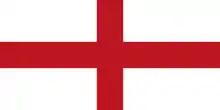

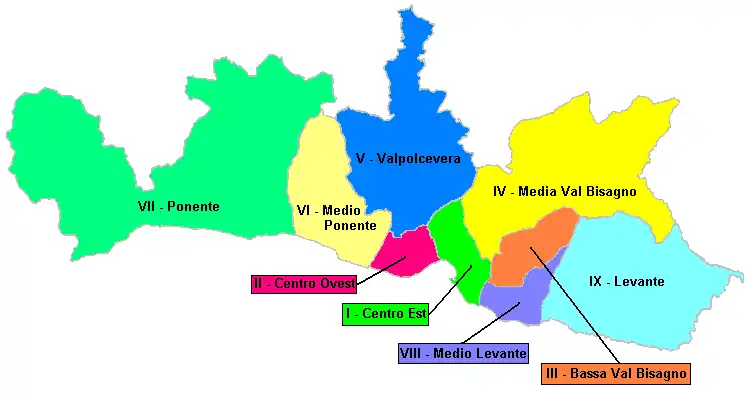
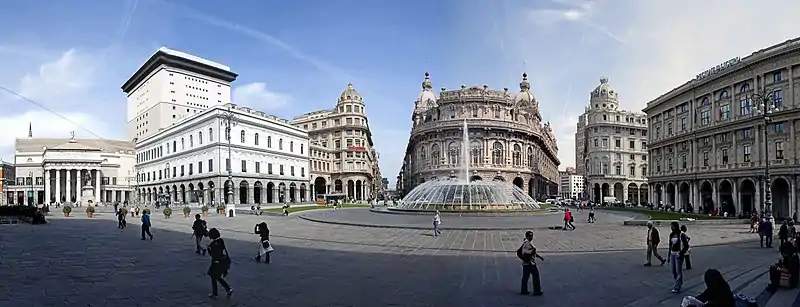

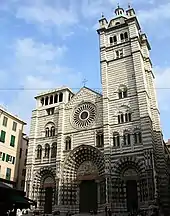
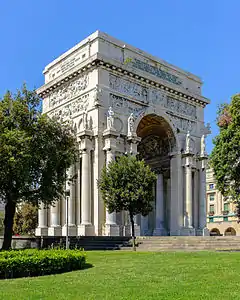
.jpg.webp)
